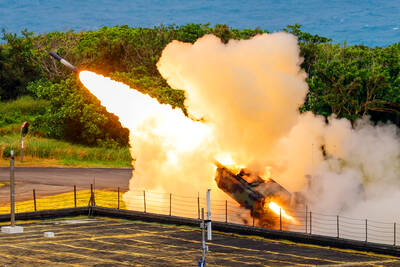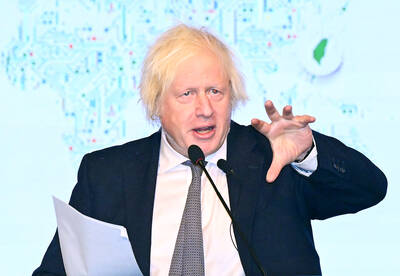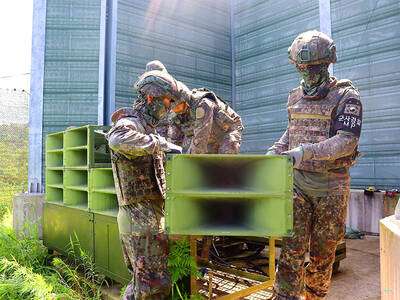Canada’s aviation giant Bombardier was expected to unveil its CSeries, a fuel-sipping “greener” rival to smaller aircraft made by industry leaders Airbus and Boeing, yesterday in Britain, local media said on Saturday.
Bombardier, a leading manufacturer in railway equipment and the third largest global builder of airplanes, is looking to deliver a model that consumes 20 percent less fuel, thanks to a new motor style and lighter composite materials, Canada’s La Presse reported.
The CSeries twin-engine aircraft seats 110 to 130 people, and would compete with Airbus’ A319 (125 seats) and Boeing’s B737-600 and 700 (110 to 130 seats).
“The Farnborough [Britain] air show officially does not open until Monday [today] but Bombardier is in the habit of making its big announcements on the eve of a show opening,” the Montreal paper’s aeronautics expert wrote.
OFF THE BACK BURNER
The company put the CSeries project on hold in May 2006, after it had been in the works for a decade, but relaunched the process last year once it appeared that rising fuel costs would ignite demand for a more fuel-efficient aircraft.
Jacques Kavafian, an analyst at Research Capital, wrote this week that “identified potential customers now include China Southern, Shanghai Airlines, Lufthansa, ILFC, and Qatar Airways.”
China Southern and Shanghai Airlines could be the main clients for the test phase of the aircraft, and have already ordered around 100 CSeries aircraft, which are available beginning in 2013.
“Interest [in the Cseries] is indeed out there,” Bombardier spokesman March Duchesne said, without providing any confirmation of the release plans.
BIG AND SMALL
Bombardier projects that after the initial production run of 100 to 150 planes, as many as 6,300 could be manufactured in the coming 20 years.
The CSeries “will be the biggest among the regional carriers or the smallest among the big airlines,” said Isabelle Dostaler, an aeronautics industry expert at Concordia University.
“That’s what worried some, ‘Why awaken the sleeping giants?’ But at the same time, Boeing and Airbus are busy with other things at the moment with their new projects. That’s the thinking,” she said.
Bombardier is later on the scene than its Brazilian rival, Embraer, which launched a 108 to 118 seat plane in 2004 as part of its E170/190 line.
The market is ruled by Europe’s Airbus and the US’ Boeing, but their A319 and B737-600 and 700 are considered aging models.
Bombardier says it will require US$2.5 billion in initial investment funds, and hopes to share the bill with the British, Canadian and Quebec governments as well as with front-end suppliers.
Potential manufacturing sites include the US state of Missouri and Mirabel, on the outskirts of Montreal.

Authorities have detained three former Taiwan Semiconductor Manufacturing Co (TMSC, 台積電) employees on suspicion of compromising classified technology used in making 2-nanometer chips, the Taiwan High Prosecutors’ Office said yesterday. Prosecutors are holding a former TSMC engineer surnamed Chen (陳) and two recently sacked TSMC engineers, including one person surnamed Wu (吳) in detention with restricted communication, following an investigation launched on July 25, a statement said. The announcement came a day after Nikkei Asia reported on the technology theft in an exclusive story, saying TSMC had fired two workers for contravening data rules on advanced chipmaking technology. Two-nanometer wafers are the most

DEFENSE: The first set of three NASAMS that were previously purchased is expected to be delivered by the end of this year and deployed near the capital, sources said Taiwan plans to procure 28 more sets of M-142 High Mobility Artillery Rocket Systems (HIMARS), as well as nine additional sets of National Advanced Surface-to-Air Missile Systems (NASAMS), military sources said yesterday. Taiwan had previously purchased 29 HIMARS launchers from the US and received the first 11 last year. Once the planned purchases are completed and delivered, Taiwan would have 57 sets of HIMARS. The army has also increased the number of MGM-140 Army Tactical Missile Systems (ATACMS) purchased from 64 to 84, the sources added. Each HIMARS launch pod can carry six Guided Multiple Launch Rocket Systems, capable of

CHINA’s BULLYING: The former British prime minister said that he believes ‘Taiwan can and will’ protect its freedom and democracy, as its people are lovers of liberty Former British prime minister Boris Johnson yesterday said Western nations should have the courage to stand with and deepen their economic partnerships with Taiwan in the face of China’s intensified pressure. He made the remarks at the ninth Ketagalan Forum: 2025 Indo-Pacific Security Dialogue hosted by the Ministry of Foreign Affairs and the Prospect Foundation in Taipei. Johnson, who is visiting Taiwan for the first time, said he had seen Taiwan’s coastline on a screen on his indoor bicycle, but wanted to learn more about the nation, including its artificial intelligence (AI) development, the key technology of the 21st century. Calling himself an

South Korea yesterday said that it was removing loudspeakers used to blare K-pop and news reports to North Korea, as the new administration in Seoul tries to ease tensions with its bellicose neighbor. The nations, still technically at war, had already halted propaganda broadcasts along the demilitarized zone, Seoul’s military said in June after the election of South Korean President Lee Jae-myung. It said in June that Pyongyang stopped transmitting bizarre, unsettling noises along the border that had become a major nuisance for South Korean residents, a day after South Korea’s loudspeakers fell silent. “Starting today, the military has begun removing the loudspeakers,”